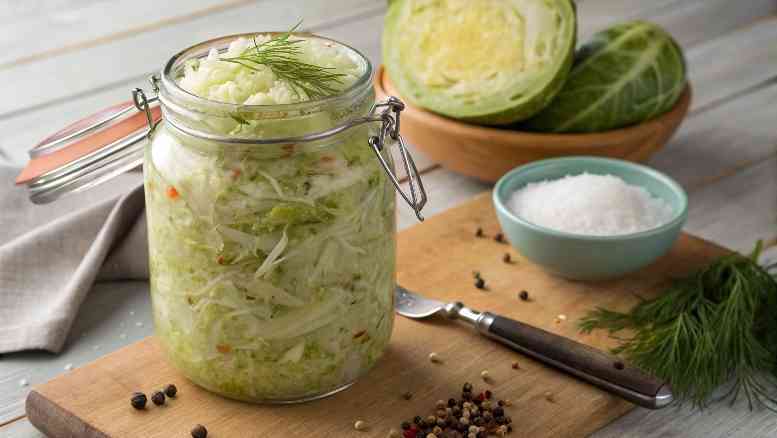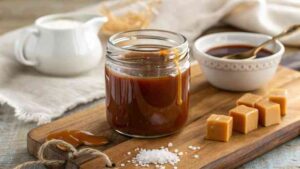Introduction
Homemade Sauerkraut is a tangy, probiotic-rich condiment, perfect for sandwiches, salads, or savory dishes. With its crisp texture and bold, tart flavor, this classic fermented cabbage delivers a gut-friendly, versatile addition to any meal. Presented in a white ceramic bowl or jar, optionally garnished with fresh dill or caraway seeds, this Sauerkraut recipe offers a vibrant, rustic aesthetic that elevates any table. This recipe provides a simple homemade version with minimal ingredients, adaptable for dietary preferences, ideal for home cooks seeking a crowd-pleasing condiment that brings wholesome, Eastern European-inspired charm to any occasion.
Ingredients
For the Sauerkraut:
- 1 medium head of green cabbage (about 2 lbs), outer leaves removed
- 1 1/2 tbsp kosher salt (non-iodized)
- 1 tsp caraway seeds (optional, for flavor)
- 1/2 cup filtered water (if needed for brine)
For Serving:
- Optional: Fresh dill, caraway seeds
- Suggested Accompaniments: Sausages, sandwiches, mashed potatoes
- Suggested Pairings: Beer, sparkling water
- Suggested Aesthetic: Serve in a white ceramic bowl or jar
- Suggested Equipment: Large mixing bowl, sharp knife or mandoline, clean 1-quart mason jar, fermentation weight or small clean jar, cheesecloth or lid, measuring spoons
Step-by-Step Process
- Prepare Cabbage: Remove the core from the cabbage and thinly slice or shred using a knife or mandoline—place in a large mixing bowl.
- Add Salt and Massage: Sprinkle kosher salt over the cabbage. Massage with clean hands for 5–10 minutes until the cabbage releases liquid and becomes soft, creating its own brine.
- Add Flavor (Optional): Mix in caraway seeds if desired for a traditional flavor.
- Pack Jar: Transfer cabbage and its liquid into a clean 1-quart mason jar, pressing down firmly with clean hands or a spoon to submerge the cabbage in brine. Leave 1–2 inches of headspace. If needed, add filtered water to cover the cabbage.
- Taste and Adjust: Taste a small amount of the brine (safe as it’s pre-fermented) and adjust with a pinch more salt or caraway seeds to ensure a balanced flavor.
- Weight and Cover: Place a fermentation weight or a small clean jar on top to keep cabbage submerged. Cover with cheesecloth or a loose lid to allow air circulation while keeping out debris.
- Ferment: Place the jar in a cool, dark place (60–70°F) for 7–14 days. Check daily to ensure cabbage stays submerged, pressing down if needed. Skim off any foam or scum that forms.
- Taste During Fermentation: After 5 days, taste the sauerkraut every few days to monitor flavor. Stop fermentation when it reaches desired tanginess (typically 7–14 days).
- Store: Seal the jar with a tight lid and refrigerate to slow fermentation. Let flavors meld for 1–2 days before serving.
- Serve: Transfer to a white ceramic bowl or serve from the jar. Optionally garnish with fresh dill or caraway seeds. Serve with sausages, sandwiches, mashed potatoes, beer, or sparkling water.
Tips for Better Sauerkraut
- Use fresh, firm cabbage for the best texture and fermentation.
- Taste the brine before and during fermentation to balance salty, tangy flavors; adjust sparingly.
- Keep cabbage submerged in brine to prevent mold and ensure proper fermentation.
- Use non-iodized salt (like kosher or sea salt) to avoid inhibiting fermentation.
- Present in a white ceramic bowl or jar to highlight the pale, tangy kraut.
- Make ahead: Prepare and start fermentation up to 2 weeks in advance; refrigerate once ready.
- Maintain a clean environment to avoid contamination; sterilize jars and tools.
- Enhance aesthetic: Garnish with dill or caraway seeds for a rustic, vibrant pop.
Variations and Customization
- Spicy Sauerkraut: Add 1 sliced jalapeño or 1 tsp red pepper flakes during massaging.
- Garlic Sauerkraut: Mix in 2 minced garlic cloves for a savory kick.
- Purple Sauerkraut: Use red cabbage instead of green for a vibrant color.
- Carrot Sauerkraut: Add 1 cup shredded carrots for a touch of sweetness.
- Low-Sodium Sauerkraut: Reduce salt to 1 tbsp, but monitor fermentation closely.
- Herbed Sauerkraut: Include 1 tsp dried dill or juniper berries for extra flavor.
- Quick Sauerkraut: Ferment for 3–5 days for a milder flavor.
- Apple Sauerkraut: Add 1 shredded apple for a slightly sweet, tangy twist.
Storage and Serving Tips
- Store in an airtight jar in the fridge for up to 6 months; flavors deepen over time.
- Freeze in small portions for up to 1 year; thaw in the fridge (may soften texture).
- Serve chilled or at room temperature for the best tangy, crisp flavor.
- Use as a condiment, side dish, or topping for hot dogs, Reuben sandwiches, or bowls.
- Pair with beer or sparkling water to complement the tart, savory flavors.
- Present in a white ceramic bowl or jar with garnishes for a rustic, wholesome charm.
Nutritional Information
Based on 16 servings (1/4 cup each):
- Calories: 15 kcal
- Total Fat: 0g
- Saturated Fat: 0g
- Trans Fat: 0g
- Cholesterol: 0mg
- Sodium: 440mg
- Total Carbohydrates: 3g
- Dietary Fiber: 1g
- Sugars: 2g
- Protein: 1g
- Vitamin A: 2% Daily Value
- Vitamin C: 30% Daily Value
- Calcium: 2% Daily Value
- Iron: 2% Daily Value
Note: Values vary by ingredient brands and substitutions (low-sodium reduces salt). Low in calories; rich in probiotics.
Conclusion
This Homemade Sauerkraut recipe delivers a tangy, probiotic-rich condiment perfect for sandwiches or savory dishes. It transforms simple ingredients into a wholesome favorite. Its straightforward preparation and rustic presentation make it a go-to. The crisp texture and bold flavor delight with every bite. It’s sure to be a cherished recipe, loved for its crowd-pleasing charm.

Homemade Sauerkraut Recipe: Tangy and Probiotic-Rich
Ingredients
- 1 medium head of green cabbage 2 lbs
- 1 ½ tbsp kosher salt non-iodized
- 1 tsp caraway seeds optional
- ½ cup filtered water if needed
- Optional: Fresh dill caraway seeds
- Suggested Pairings: Beer sausages
Instructions
- Slice cabbage thinly; place in a bowl.
- Add salt; massage for 5–10 minutes until juicy.
- Mix in caraway seeds; taste and adjust the brine.
- Pack into a 1-quart jar; submerge in brine.
- Add weight; cover with cheesecloth.
- Ferment 7–14 days at 60–70°F, tasting periodically.
- Refrigerate when tangy; serve in a white ceramic bowl.
Notes
- Keep cabbage submerged to prevent mold.
- Store in the fridge for 6 months or freeze for 1 year.
- Try a spicy or garlic variation.
- Pair with sandwiches.









